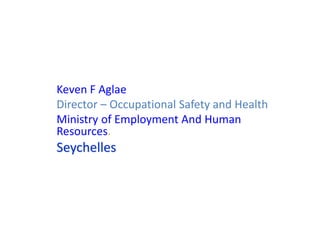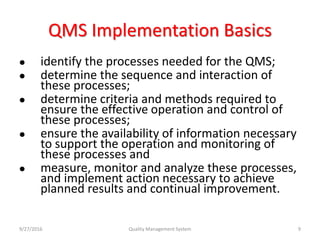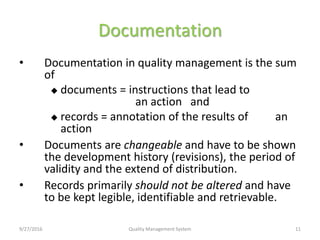Quality Management System - Objectives
- 1. Keven F Aglae Director – Occupational Safety and Health Ministry of Employment And Human Resources. Seychelles
- 2. Quality Management System - Unit Objectives Targeted Group: Medical Radiologist Duration: three Weeks Number of Participant: 8 - 10 Methods : lecture/Group discussions Assessment. Research. Attendance certificate 9/27/2016 2Quality Management System
- 3. Quality Management System Unit Objectives The objectives of this unit is to outline the principles of quality management system. To stress the importance of effective quality management. Should understand the basic concepts of quality management, and how to apply them in the workplace.(Radiological Unit) Main components of the quality Management. 9/27/2016 3Quality Management System
- 4. What is Quality • The quality can be defined as ‘the totality of features of a product or service that bears its ability to satisfy given needs’ • quality relates to – Fitness for use – Fitness for purpose • Quality refers to certain standards and the ways and means by which those standards are achieved, maintained and improved upon. 9/27/2016 4Quality Management System
- 5. What is Quality Management Quality Management is a set of rules, which an organization uses internally • to assure that the products and services, which it delivers to it’s customers satisfy customers needs and also • his expectation and • are produced correctly • at acceptable costs. 9/27/2016 5Quality Management System
- 6. Main components of the Quality Management Two main components of the quality management (ISO9000:2000) quality assurance (QA) and quality control (QC) QA is an interdisciplinary management tool that provides a means for ensuring that all work is adequately planned, correctly performed and assessed; QC is a means of applying controls to the process to ensure that the product or service consistently meets specifications. 9/27/2016 6Quality Management System
- 7. Difference Certification - Accreditation • Certification only states that an organisation is operating according to a set of rules complying to relevant (international) standards. • A certificate does not guarantee that the products are of top quality. • Accreditation not only confirms that a QM- system according to relevant standards is in operation, but also that the organisation is competent in performing measurements, tests, inspections or calibrations. • It guarantees (to the extend of human error) that the results are correct. 9/27/2016 7Quality Management System
- 8. International Standards for Quality Management •The ISO9000 standards series: Present a concept ISO9000 Present requirements ISO9001 Present guidelines ISO9004 ISO17025 General requirements for the competence of testing and calibration laboratories ISO10012 Quality assurance requirements for measuring systems 9/27/2016 8Quality Management System
- 9. QMS Implementation Basics identify the processes needed for the QMS; determine the sequence and interaction of these processes; determine criteria and methods required to ensure the effective operation and control of these processes; ensure the availability of information necessary to support the operation and monitoring of these processes and measure, monitor and analyze these processes, and implement action necessary to achieve planned results and continual improvement. 9/27/2016 9Quality Management System
- 10. QMS Implementation Process 1. Decision taking 2. Management commitment 3. Implementation team 4. Plan the implementation 5. Identify existing processes 6. Define document structure 7. Write 8. procedures 9. Initial Training of personnel 10. Implementation 7. Internal Audit 8. Management Review 7. Improve system 9/27/2016 10Quality Management System
- 11. Documentation • Documentation in quality management is the sum of documents = instructions that lead to an action and records = annotation of the results of an action • Documents are changeable and have to be shown the development history (revisions), the period of validity and the extend of distribution. • Records primarily should not be altered and have to be kept legible, identifiable and retrievable. 9/27/2016 11Quality Management System
- 12. ISO17025 • This standard contains all the requirements to demonstrate that companies operate a quality management system and are technically competent and able to generate technically valid results. 9/27/2016 12Quality Management System
- 13. ISO17025 Management requirements 1. Organization 2. Quality system 3. Document control 4. Review of requests, tenders and contracts 5. Subcontracting 6. Purchasing 7. Service to the client 8. Complaints 9. Control of nonconforming testing/calibrations 10. Corrective action 11. Preventive action 12. Control of records 13. Internal audits 14. Management reviews 9/27/2016 13Quality Management System
- 14. Seychelles 14 14













